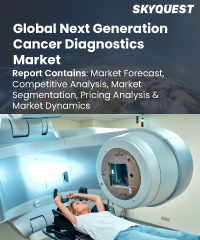
Report ID: SQMIG35A2226

Report ID:
SQMIG35A2226 |
Region:
Global |
Published Date: September, 2024
Pages:
219
|
Tables:
67 |
Figures:
77
Global Next Generation Cancer Diagnostics Market size was valued at USD 11.60 Billion in 2022 and is poised to grow from USD 13.66 Billion in 2023 to USD 43.02 Billion by 2031, at a CAGR of 17.8% during the forecast period (2024-2031).
The market is moving towards the replacement of traditional method laboratory testing by rapid point-of-care testing, which is on account of commercialization of technologically advanced products like diagnostic devices, kits and reagents. This shift led to the significant rise of the market rate. With the emergence of companion diagnostics, high-value opportunities are projected to grow as companion diagnostics become more imminent even within delivering advanced and personalized genomic medicine. The rising global prevalence of diverse types of cancers only proves this by reinforcing the need for such supportive diagnostic tools. For instance, In 2020, Over 544,00 cases of non-Hodgkin Lymphoma, over 83,0 Of Hodgkin lymphoma reported globally are; diabetic Leukemia that saw over patient and have Multiple myeloma guarantees a report of about 176,. WHO declared that the second-largest factor of mortality – cancer, is about providing 9.6 million deaths globally per year.
The mammoth value is also attributed to the increasing occurrence of cancer, which strengthens demand for advanced diagnostic tools as well as newer cancer biomarker development. If advanced diagnostics are the factors that promoted early cancer detection, such a detection usually results in better treatment solutions. The development of next-generation cancer diagnostics has improved the accuracy and cost-effectiveness of detecting any cases. In its turn, studying ensues every day in order to come up with new minimally invasive techniques about cancer diagnosis which underlines the importance of early detection that leads to positive patient outcomes. The segment tends to reflect upon the ongoing approach that has been adopted by many, in addressing the challenges faced when it comes to healthcare posed on the globe with more than 137,000 cases reported each year such as cancer mortality rates noted above 44%.
US Next Generation Cancer Diagnostics Market is poised to grow at a sustainable CAGR for the next forecast year.
Our industry expert will work with you to provide you with customized data in a short amount of time.
REQUEST FREE CUSTOMIZATIONWant to customize this report? This report can be personalized according to your needs. Our analysts and industry experts will work directly with you to understand your requirements and provide you with customized data in a short amount of time. We offer $1000 worth of FREE customization at the time of purchase.

Report ID: SQMIG35A2226